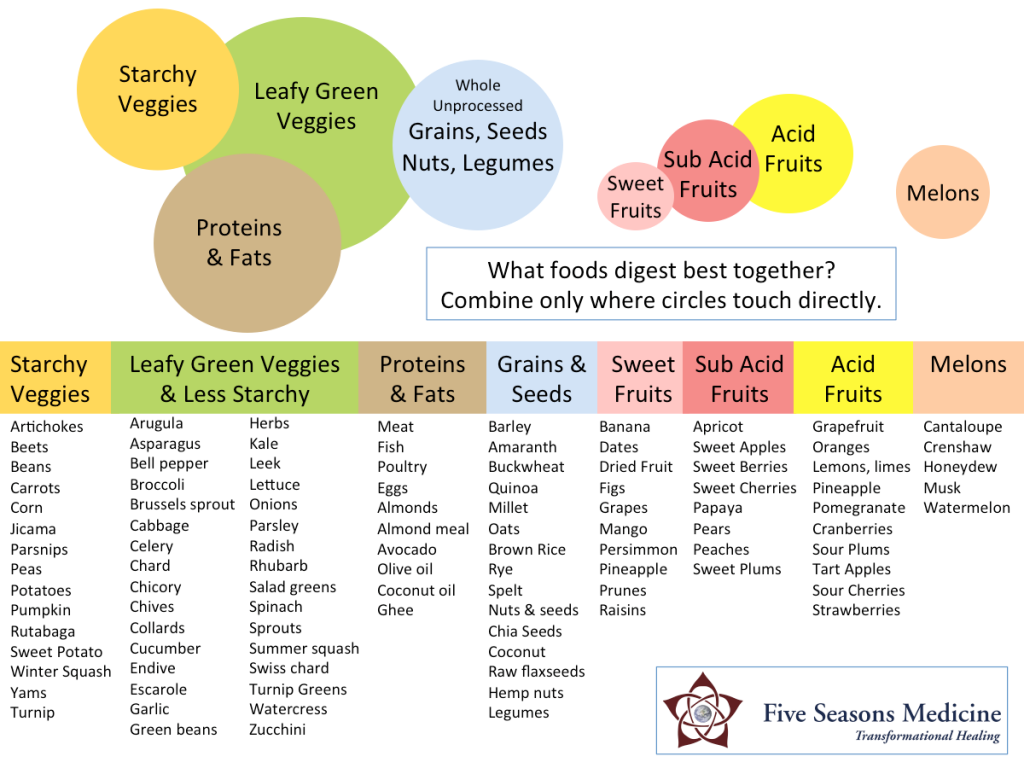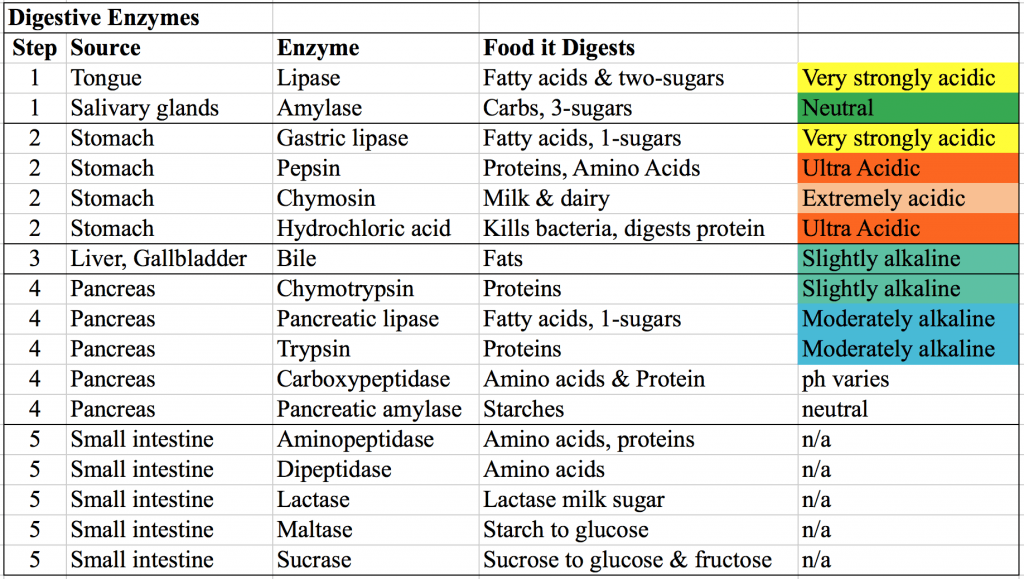You spend time and money on the healthiest foods. But how much of it do you actually absorb into your cells? Turns out food combining has a major effect on your digestive efficiency. Foods that digest well together make for a healthy inner ecology. Smart food combining makes your tummy happy. Poor food combining is a major cause of sluggish brain, heartburn, GERD, flatulence and emotional stress. If you want to optimize your health and save money, food combining is your secret friend.
Increase your assimilation with conscious food combining. Aha!
Research says humans assimilate between 10% and 80% of the food we eat, with the average somewhere between 40 and 60 percent. The undigested food is excreted, recycled back into the Earth. Well, that’s a very large range. How much YOU assimilate fluctuates constantly and is pretty hard to measure. The primary factors are: how well you chew your food, the nutrient-density of the food, the type of food (i.e. starches, proteins, fats), whether it is raw or cooked, the level of life force in the food, enzymes present, your intestinal flora, the health of your organs, your emotional state, stress level, and the amount of toxins, empty calories, or useless material to be eliminated. Other important factors are your metabolism rate, exercise and activity level, the quantity of food you eat, your age, the time of day, your internal body temperature, and the temperature of the food consumed. Wow!
Scientific Studies of Animals Show Different Rates of Absorption
- Grazers like cows assimilate 20-40% of the energy from grass, and the rest is excreted. (Have you seen a cow pie recently? It’s mostly undigested grass.)
- Animals who live on young shoots and new leaves absorb 60 to 70% of the energy taken in. Think giraffes and deer.
- Seed-eaters like squirrels absorb up to 80% of their food.
- Carnivores assimilate 80 to 90% of their food eaten, the highest percentage.
What about humans? Humans are omnivores. Energy assimilation of meats is generally higher than that of plants. Studies show that light cooking of plants increases its bio-availability, so that more of the nutrients can be absorbed. Hence raw food is somewhat more difficult to digest. Your personal absorption rate depends on what you eat and the factors above. For more details on counting, see my article Still Counting Calories and Carbs?.
What is Food Combining?
Effective food combining allows each type of food to pass through the digestive system with ease, and ensures it is absorbed. Bad food combining is a primary factor that causes gas, flatulence, heartburn, upset stomach, inflammation, and other issues. Even worse, the resulting poor digestion can cause malnutrition and nutritional deficiencies, even if you’re eating a healthy diet. Preventing disease is not just about eating healthy – you’ve got to absorb it. It’s also equally important to eliminate toxins so they don’t sit around in your body. And eliminating toxins requires a healthy digestive system
The Critical Steps in Healthy Digestion
Digestion starts by putting food or liquid into your mouth. You chew, swallow, and your digestive organs each do their job to break it down into molecules so you can absorb it. What your body doesn’t use is excreted as waste. Digestion takes place primarily in your mouth, stomach, small intestine. Elimination happens in the large intestine.
Food combining takes into account the type of food to ensure it goes through your digestive system with ease. Digestion’s first step is chewing, a mechanical process to liquefy the food as much as possible. After you chew and swallow, the digestive process is mostly chemical, using many enzymes which break down each type of food. For example, starches like carbs require amylase enzymes in the mouth, and lots of chewing. When you chew your food well into tiny pieces, it can be more easily broken down into molecules by the chemicals further along the line. Proteins are digested in the stomach with hydrochloric acid secreted by the stomach walls. Pepsin enzyme is also poured into the stomach. The intelligence of your body is amazing.
There are three primary categories of food: proteins, carbohydrates, and fats. Proteins are digested chemically in the stomach. Carbohydrates are divided into two categories: fruits and starches. Fruits pass through your digestive system quite easily. Starches require three levels of breakdown, first in the mouth, second in the stomach, and third in the small intestine. But the body can’t do its job of breaking down the starches chemically unless it’s already chewed into tiny pieces. That’s why it’s so important to chew starchy foods very well.
The Science of Food Combining
Different food types require different enzymes to be secreted in your stomach, and each enzyme needs either an acid or alkaline environment in which to break down your food. Food combining guidelines say you do not want to mix proteins and starches in the same meal. This means no bun with your hamburger, no meatballs over pasta, no potatoes with your meat. Here’s why:
Starches require an alkaline digestive medium to digest. But the stomach is an acid environment. If you mix proteins and starches in the same meal, you’re mixing acids and alkaline foods. Any chemistry student will tell you that acids and alkali neutralize each other. Then what happens? The stomach tries to do its job for a few hours. And when it’s had enough, it sends the whole batch down to the intestines and says “ok, you work on this for a while”. This creates a mess in the intestines – inflammation, partially digested food, the accumulation of mucoid plaque, poor absorption, candida, fermentation of some foods, and general bacterial chaos. Finally the food is excreted out of the system. Disease can result, and it can be anything from leaky gut, to inflammation, food allergies, to SIBO, or obesity.
The graphic below illustrates what foods combine well and those that don’t. Combine only where the circles touch directly.
The Three Big Guidelines of Food Combination
-
- No proteins and starches at the same meal. They neutralize each other and prevent proper digestion of either food. To ensure proper digestion of each food, wait two hours after eating a starch before eating protein. And wait three hours after eating protein before eating a starch.
- No fruits and vegetables at the same meal. Fruits are either single or double sugars, whereas starches are a triple sugar. Fruits mechanically break down in your stomach, but they don’t break down chemically until they reach the third stage of digestion in the intestines. Starches, are also broken down in three different stages: mouth, stomach, intestines. Simply put, fruits mixed with other foods will either ferment into something awful, or they’ll be sent out through the elimination and not absorbed.
- Eat melon alone, or skip it. Melons do not digest well with other foods and will frequently cause problems unless consumed alone. Remember watermelon after a big picnic? Remember the stomach ache after your mixed fruit cocktail dessert after a big meal?
Dessert after a meal can ruin your digestion. Unless dessert matches the foods in your meal, it will be trapped in your stomach with all that other food, where it may rot or ferment because the chemicals have cancelled each other out. It’s far better to eat fruit 30-60 minutes before dinner. The same applies if you want to eat another type of fruit. Acidic fruits such as lemons do not combine well with starchy fruit like bananas. Lemon and banana together are an invitation to gastrointestinal upset. See the images below of each step in the digestive process.
What are the enzymes doing?
There are over 17 different enzymes involved in the digestive process. Each enzyme has a specific ph designed to work on a type of food. Enzymes are secreted at each digestive step in the mouth, stomach, liver, pancreas, and small intestine. Digestion begins in the mouth with Lipase and Amylase for carbs and sugars. The stomach is a very acidic environment. Bile is secreted by the liver to help digest fats. The pancreas is a busy enzyme factory that sends digestive chemicals into the small intestine. Other enzymes are produced by the small intestine, about 6 meters or 20 feet long.
Simplify your meals, Optimize your digestion.
You can help your body assimilate your food by eating simple meals that use the same enzymes. Then wait 3 hours, and have another meal of different types of food. Here are some of the enzymes in the digestive process, and their ph.
Sources:
http://www.mindbodygreen.com/0-6851/10-Food-Combinations-to-Improve-Digestion.html
https://en.wikipedia.org/wiki/Gastric_acid
https://en.wikipedia.org/wiki/Pancreatic_juice
http://www.scienceclarified.com/Di-El/Digestive-System.html
https://scioly.org/wiki/index.php/Digestive_Secretion_List
http://thecellularrestorationdiet.com/food_combining.html
http://www.yahwehsaliveandwell.com/pages/foodcombining.htm
Asheley Cockrell Skinner, Eliana M. Perrin and Joseph A. Skelton. Prevalence of obesity and severe obesity in US children, 1999-2014. Obesity, April 2016 DOI: 10.1002/oby.21497.
Suzanne Devkota, Yunwei Wang, Mark W. Musch, Vanessa Leone, Hannah Fehlner-Peach, Anuradha Nadimpalli, Dionysios A. Antonopoulos, Bana Jabri, Eugene B. Chang. Dietary-fat-induced taurocholic acid promotes pathobiont expansion and colitis in Il10?/? mice. Nature, 2012; DOI: 10.1038/nature11225.
Meng Yang, Stacey A. Kenfield, Erin L. Van Blarigan, Julie L. Batista, Howard D. Sesso, Jing Ma, Meir J. Stampfer, and Jorge E. Chavarro. Dietary Patterns after Prostate Cancer Diagnosis in Relation to Disease-Specific and Total Mortality. Cancer Prevention Research, June 2015 DOI: 10.1158/1940-6207.
http://www.wholeapproach.com/candida-diet/foodcombining.php
http://www.acidalkalinediet.com/food-combining#.WHrdaDuBhg0
http://rawgourmet.com/2014/12/gerd-heartburn-how-food-combining-can-help/
http://www.livebeaming.com/2012/12/food-combining-for-better-digestion-metabolic-function/







5 Replies to "How Much of Your Food Do You Actually Absorb?"
frank July 24, 2021 (10:13 am)
Jane-
I shared your article with the folks at The Motley Fool, Health and Nutrition blog pages, and got quite a bit of (negative) reaction.
See:
https://boards.fool.com/health-and-nutrition-112919.aspx?mid=34883747
Specifically, from the writer who identifies herself as “VeeEnn”.
Can you comment?
If you like, I will post your response on the blog, responding to “VeeEnn’s” comments.
Frank Bostrom
Jane Barthelemy July 24, 2021 (5:57 pm)
Hi Frank, thanks for this interesting discussion. I write about maximizing health, from personal experience with the gut. The practice of food combining has helped me keep my digestive track clean, efficient, and relatively undisturbed by putrid fermentation. I buy only the best food, and I don’t overeat. This way I never gain weight or experience digestive distress.
Food combining is not for everyone, as I’ve noticed some people seem to live very well on a diet of meat, potatoes, and fruit, all at the same meal. That way of eating would make me ill – but I’m an especially sensitive creature. Thanksgiving is a prime example of “poor food combining”. It takes me HOURS to process what went in. That’s why I’ll be a selective eater if you invite me for Thanksgiving at your house. However the human digestive system is extremely resilient, designed to keep us alive under all circumstances. Just how efficient – we don’t know because we don’t study what we can’t see.
The idea that we absorb more of our food if we eat carefully is not new. The scientific basis is limited – not sure how would we could measure the nutrient value of food INJESTED, and somewhat later that of food COMING OUT UNPROCESSED – a messy research project indeed. Ha Ha! There’s much we don’t know about digestion. It’s largely hidden from view, a subject too near and dear to our hearts, not to mention closely linked to our ancestry and emotions.
My objective is simply to share how I’ve learned to feel well, to keep my burps clean, my poop not smelly, and the food processed within an hour or two so I can move on to the next feast. To each his own. Thanks for sharing this interesting debate! Jane
frank July 22, 2021 (6:52 am)
ANOTHER minor typo on one of your pages:
https://janeshealthykitchen.com/food-combining/
Typo:
Simply put, fruits mixed with other foods will either ferment into something awful, or they’ll be send out through the elimination and not absorbed.
Should be: “…or they’ll be SENT out through the elimination…”
Jane Barthelemy July 23, 2021 (6:28 am)
Gratitude! I fixed both errors. A special thank you to you, Frank!
Jane
frank July 22, 2021 (6:43 am)
minor typo on one of your pages:
https://janeshealthykitchen.com/food-combining/
The graphic below illustrates what foods combine well and this that don’t.
Should be: “and THOSE that don’t”